Tom Schilling Never Look Away
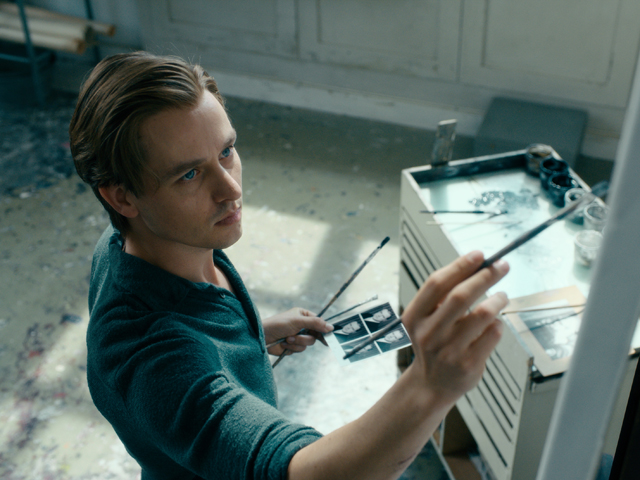
Werk ohne Autor
Cast: Tom Schilling, Sebastian Koch, Paula Beer
Director: Florian Henckel von Donnersmarck
Genre: Drama, History, Thriller
Rated: MA
Running Time: 189 minutes
Synopsis: Inspired by real events and spanning three eras of German history, Never Look Away tells the story of a young art student, Kurt (Tom Schilling) who falls in love with fellow student, Ellie (Paula Beer). Ellie's father, Professor Seeband (Sebastian Koch), a famous doctor, is dismayed at his daughter's choice of boyfriend, and vows to destroy the relationship. What neither of them knows is that their lives are already connected through a terrible crime Seeband committed decades ago.
Never Look Away
Release Date: June 20th, 2019
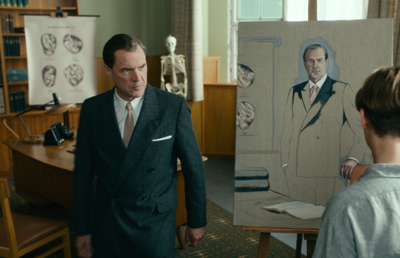 About The Production
About The Production
With his third feature film, Florian Henckel von Donnersmarck, winner of the Academy Award® for Best Foreign Language Film, three European Film Awards (including for Best Film and Best Screenwriter), and seven German Film Awards (including for Best Feature Film, Best Direction, and Best Screenplay) for his debut film The Lives Of Others (2006), returns to Germany.
Here he explores a subject matter that is both unusual and compellingly ambitious, spanning three decades of German post-war history in a suspense-packed drama. It also makes use of a sweeping historical backdrop to tell a highly personal and emotional story through the portrayal of three human destinies. A gripping drama and moving family story inspired by real events, by what it means to create art, and by the search for an artistic voice of one's own. For Florian Henckel von Donnersmarck, art and the creative process it entails are major themes.
He was not yet ten years old when his mother took him and his older brother to the groundbreaking Zeitgeist "exhibition in Berlin's Martin Gropius Bau" – the exhibition would have a lasting influence on the boy, in a sense also laying the foundations for Never Look Away as it kindled his interest in art. The actual idea for the film came much later, however, born of Henckel von Donnersmarck's growing interest in art in general, and more specifically his inspiring encounter with the work of German painter Gerhard Richter, whose life and work serve as one of the film's many sources of inspiration. "In recent years I found myself continually encountering the work of Gerhard Richter at important moments and with important friends of mine – at the homes of Ulrich Mühe (The star of The Lives Of Others), of my agent Beth Swofford in Los Angeles, and of a friend of mine in New York, Noam Gottesman. I was unable to forget these images of Gerhard Richter even weeks and months after I saw them. They were like memorable melodies that continue to dance around in your head. Like earworms. But in this case eyeworms.
With the difference that they weren't annoying, but a continual source of enrichment."
In 2014 the author and director made the decisive move that led to Never Look Away. The idea of making a major film about German art in the period following the Second World War wouldn't leave him in peace. His colleague Jan Mojto, with whom he co-founded the production company Pergamon Film, was so excited by the proposal that other projects were immediately laid aside. "We had already been planning two specific projects for a long time: one I had been researching for many years, and we had finally obtained the rights for another after waiting ten years. I was sitting with him in his office and we were discussing very concrete plans for the other screenplay and other shooting. I said: 'Jan, I don't want to mess up everything that we're working on, but there's a film idea I've been thinking about for a long time. I want to at least tell you about it and would like to make it at some point with our company.'" Mojto was immediately enthusiastic and urged Henckel von Donnersmarck to begin writing the screenplay straight away.
Jan Mojto comments: "The screenplay was ready in autumn 2015, perfectly on schedule. When I began reading it, I couldn't stop. It was the same way ten years ago with The Lives Of Others.
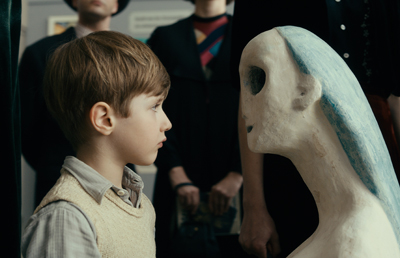 And so it was easy for me to give the green light the very next morning. Why? Because Florian succeeded in weaving abstract-sounding themes like "the suffering of the perpetrators" and questions like "What is the defining quality of the Germans?" and "Where does art come from?" into a sweeping and emotional story. This promise was not only fulfilled but exceeded. Never Look Away is a great film about Germany – made from within Germany and for the world."
And so it was easy for me to give the green light the very next morning. Why? Because Florian succeeded in weaving abstract-sounding themes like "the suffering of the perpetrators" and questions like "What is the defining quality of the Germans?" and "Where does art come from?" into a sweeping and emotional story. This promise was not only fulfilled but exceeded. Never Look Away is a great film about Germany – made from within Germany and for the world."
Florian Henckel von Donnersmarck's long-time colleagues Quirin Berg and Max Wiedemann (Wiedemann & Berg Film), who had also produced The Lives Of Others, likewise joined the new project. "We were students together at the HFF Munich, and of course shared an intense and exciting experience during the production of The Lives Of Others," explains Quirin Berg. "Through the years, we have continued to talk with each other about new projects. It was always clear to Florian that he was going to work in America – but also that he would return to Europe." Max Wiedemann describes the filmmaker and what makes him totally unique: "He is 6 feet 8 inches tall. He was born into one of Germany's oldest families. He studied in Oxford and speaks five languages. He won an Oscar® with his debut film. He mobilizes incredible energy to realize his vision; he is a fighter, a force of nature. At the same time, he is a sensitive and curious intellectual, a brilliant creative person and an artist. Ambitious projects necessitate both – a subtle vision, and also the strength to implement it in the right way. This was already there in The Lives Of Others, but he has continued to evolve over the years in between and have accumulated much more experience."
Quirin Berg confirms the exceptional qualities of the author and director: "Florian is never tentative" he notes. "He focuses on a theme thoroughly, penetrating to its core. He takes whatever time is needed for this process of searching and development. And when he goes on to write the screenplay, the first version is already incredibly precise. We read this version and there were no doubts whatsoever – it was extraordinary." And Max Wiedemann elaborates: "Never Look Away explores the question of how great, genuine art is created. Art is one of the mysteries of human creativity. There is no formula that can determine why a work of art moves, shocks, or captivates us. What could be more fascinating than to delve into this question and process?"
Wiedemann adds: "For a long time the cinematic treatment of German history fixated on the Second World War, and naturally on the GDR past. One of the things that particularly excited us about Never Look Away was that the film covers several periods of German history and connects the developments in each." The film sheds light on these periods from the perspective of three human destinies: of the artist Kurt Barnert, the love of his life Elisabeth, and her father Professor Seeband. All three are invisibly bound by a dark family secret of which Kurt and Elisabeth are at first completely unaware.
The extended time frame covered by the film posed special challenges in making it. "The story takes us through three decades of German history: war, destruction, reconstruction, Socialism, the young Freedom Republic of Germany. But the film's focus is above all on the art of this period, on the work of our main character Kurt – and his path to finding his own personal style as an artist," notes Quirin Berg.
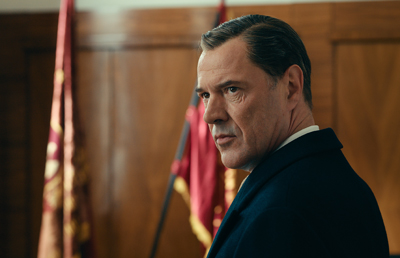 This required a dimension of research and production of artworks that was unprecedented for a film – even to the point of an elaborate recreation of the historic exhibition Entartete Kunst ("degenerate art") with its key works, for which our scene painters collaborated with the staff of the artists' archives. The painting Kriegskrüppel ("war cripples") by Otto Dix is an example. They reconstructed the painting, which – like many others – was destroyed after the exhibition, and of which only a small black-and-white image existed. The archive helped us determine the materials and exact colors that Dix had used. In addition, the production involves locations in Dresden, Großschönau, Russia, Italy, Berlin, and Düsseldorf. And shooting locations in Berlin, Dresden, Görlitz, Poland, Prague, and Düsseldorf. With heads of departments from Germany, Italy, England, and the U.S.
This required a dimension of research and production of artworks that was unprecedented for a film – even to the point of an elaborate recreation of the historic exhibition Entartete Kunst ("degenerate art") with its key works, for which our scene painters collaborated with the staff of the artists' archives. The painting Kriegskrüppel ("war cripples") by Otto Dix is an example. They reconstructed the painting, which – like many others – was destroyed after the exhibition, and of which only a small black-and-white image existed. The archive helped us determine the materials and exact colors that Dix had used. In addition, the production involves locations in Dresden, Großschönau, Russia, Italy, Berlin, and Düsseldorf. And shooting locations in Berlin, Dresden, Görlitz, Poland, Prague, and Düsseldorf. With heads of departments from Germany, Italy, England, and the U.S.
Asked about the models for the artists in his film, Florian Henckel von Donnersmarck answers: "Firstly, of course, Richter, Beuys, Polke, Uecker, Mack, and the other great Düsseldorf artists of the period. And then also Warhol and Yves Klein, Lucio Fontana. I also incorporated experiences from Thomas Demand's student years in Düsseldorf, and from Andreas Schön's as well. And of course, from my own time at the Film University in Munich. Then a number of artists came to visit us on the set and also contributed their ideas – the great Andreas Gursky came for a few days. Albert Oehlen visited us on the set with his daughter. Of course, I prepped them with questions in order to make everything even a bit more authentic."
But underscoring what is crucial to him, he says "It is not a roman à clef where I only would have changed the names out of politeness. In portraying the characters, I took the liberties I needed in order to tell my story. The film is not intended to be a documentary." The focus of Never Look Away is an artist named Kurt Barnert, played by Tom Schilling, well known from such films as the German Film Award-winning OH BOY and the internationally acclaimed box-office hit Who Am I (also a Wiedemann & Berg production). While Kurt is growing up during the Second World War, his aunt sparks his interest in art; after the war he studies first in Dresden, and later in Düsseldorf at the legendary art school Kunstakademie, where at the time some of West Germany's most important artists completely revolutionized their field. His love of Elisabeth Seeband leads to a confrontation with her father, the famous gynecologist Professor Carl Seeband, a staunch rationalist and perfectionist who despises everything that Kurt stands for.
"Kurt Barnert's life makes it clear that we as humans have an almost alchemistic ability to make something good out of the difficult things in life that happen to us all," Florian Henckel von Donnersmarck notes. "Gerhard Richter was asked about the power of art. The gist of what he said was that he believed this was the wrong word. For him art didn't have any power; rather, it exists to give consolation. I reflected for a long time about what he meant. I believe it means that every great work of art is concrete evidence that trauma can be transformed into something positive."
Tom Schilling has known the director since 2000, when they met at festivals – Henckel von Donnersmarck in connection with his short film Dobermann, the actor with Hans-Christian Schmid's Crazy. "I was at film school at the time, and he was actually still in high school," the filmmaker recalls. "Later I saw him in Jan-Ole Gerster's tender and melancholy comedy Oh Boy and also in the remarkable miniseries Generation War by Philipp Kadelbach." Henckel von Donnersmarck was very enthusiastic about collaborating with his lead actor: "I can't imagine a more precise and subtle actor or anyone who fits the role better. Tom Schilling understands everything, is always perfectly prepared, and has an unerring sense of how to defend, against everything, the dignity of the character he is playing. While shooting he consistently and reliably creates moments of great intimacy in spite of the enormous personnel and all the technology. This requires a power of concentration that is only found in the truly great actors. For me, Tom Schilling is one of these."
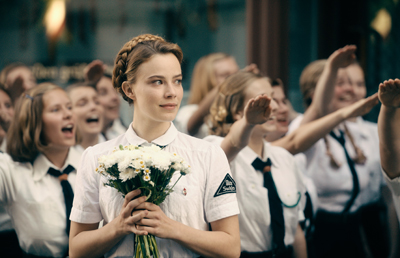 Tom Schilling still remembers his first thoughts after reading the screenplay: "It doesn't often happen that I say: 'I'm the right one for this part, I've got to play this.' In this case something clicked immediately. But there was also a personal component: I actually never wanted to become an actor but dreamed of one day becoming a painter. I was thus able to fulfill a longcherished dream."
Tom Schilling still remembers his first thoughts after reading the screenplay: "It doesn't often happen that I say: 'I'm the right one for this part, I've got to play this.' In this case something clicked immediately. But there was also a personal component: I actually never wanted to become an actor but dreamed of one day becoming a painter. I was thus able to fulfill a longcherished dream."
The complete antithesis of Kurt Barnert is his father-in-law Professor Carl Seeband, played by Sebastian Koch, who had already been featured as the lead in Henckel von Donnersmarck's Oscar®-winning The Lives Of Others, a role that launched him to international stardom. The director comments: "The character of Seeband is a dyed-in-the-wool Nazi and witnessed the complete failure of this ideology and how it brought about his country's collapse. He then found safe harbor in the next systems, however, and with his discipline, health, intelligence, and scientific expertise, remains unassailable. It was these qualities that also enabled him to conceal his guilt and save his neck. This gives him a feeling of superiority and a great feeling of security. This is why he finds it so inconceivable that his only child becomes involved with a powerless artist, whom he also deems frail and of mediocre intelligence. He opposes the relationship with every means available to him."
Sebastian Koch was the first actor Florian Henckel von Donnersmarck told about the project: "Departing from my principle as an author of creating the characters as real people and not for a specific actor, the role of Professor Seeband is tailor-made for Koch. I simply couldn't imagine any other actor for it. For me Sebastian Koch is truly a creative partner. I discuss pretty much everything with him."
Koch realised immediately that the subject had a lot of connection with his friend Florian and the things that interest and matter to him. "Florian and I have a very close and trusting friendship. We chat regularly and talk about the things that matter to us, the subjects that interest us, the projects we're working on. I remember when he first told me about his idea for Never Look Away. I immediately realised that it was an exceptional subject."
Koch was fascinated above all by the relationship between Seeband and Kurt: "The clash of two men who at first glance have nothing in common, both brilliant minds but who could not be more different, and who also have completely opposing approaches to life and the world. (…) The subject derives its power from the clash of these two men, and the result is a story about the essence of inspiration and the power of art."
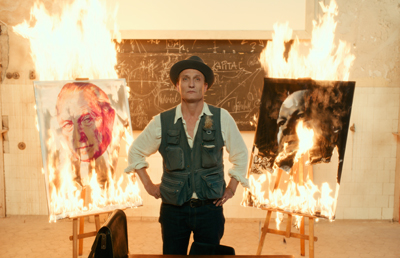 Characterising Seeband, he adds: "Seeband is a monster. He is ice-cold and domineering. But what is truly monstrous about him is that he is convinced he is doing the right thing. There is no feeling of wrongdoing, no sense of guilt. He does what he does because for him there is absolutely no alternative."
Characterising Seeband, he adds: "Seeband is a monster. He is ice-cold and domineering. But what is truly monstrous about him is that he is convinced he is doing the right thing. There is no feeling of wrongdoing, no sense of guilt. He does what he does because for him there is absolutely no alternative."
Florian Henckel von Donnersmarck continues: "Professor Seeband's way of thinking was very, very foreign to me. But I still wanted to portray him from the inside. I wanted to understand him. And so I let myself be guided by texts that might have influenced him, above all Nietzsche and Wagner, and searched for books that could possibly give me positive insight into his disciplined soul, like the writings of Ernst Jünger, for example."
No less important a role is Ellie Seeband, the professor's daughter, whom Kurt Barnert falls in love with without knowing who her father is and without knowing that they are bound by tragic circumstances in the past. Acclaimed young star Paula Beer took on this role. "I did screen tests with a considerable number of actresses for the role of Ellie," the director recounts. "There were many good actresses among them. But Paula Beer had such assurance in terms of style and taste and was such a good fit as Sebastian Koch's daughter, that it was soon clear that she was right for the role. In her performance she reveals a striking maturity – at the same time, she has the beauty of someone in her early twenties. With her old-fashioned, ladylike charm she sometimes seems like she belongs to a different era, yet she also has the strength and naturalness of a modern woman. Paula Beer has simply everything. She is a godsend for any director." Paula Beer sums up her work on the set "When acting you often lose sight of the forest for the trees because you are so immersed in your character. But since Florian also wrote the screenplay, he can explain to you even the slightest detail. He knows the characters inside out and so can guide you through every scene."
Florian Henckel von Donnersmarck also praises Saskia Rosendahl and Oliver Masucci, who both play key characters in the life of Kurt Barnert. About Rosendahl, who appears as Kurt's aunt Elisabeth, he says: "The screen tests with Saskia Rosendahl were a very emotional experience."
Casting agent Simone Bär had planned two days of screen tests for the role of Aunt Elisabeth with many different actresses – one hour per actress. "When Saskia Rosendahl began performing the scene at the piano, a shiver ran down my spine. Aunt Elisabeth was standing there before me, just as I had written her," he remembers. "She was freedom, art, beauty, extreme sensitivity, and madness all in one." To make sure his impression didn't deceive him, he had her repeat the scene one more time, with the instruction to "turn it up a notch, raise the level of madness a little."
Henckel von Donnersmarck was thrilled. "It was just as powerful, only up a notch, a little bit crazier." He gave the actress the role on the spot.
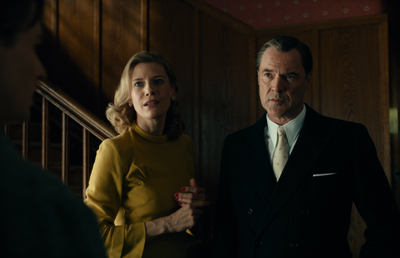 About Oliver Masucci, who plays Kurt Barnert's professor at the Kunstakademie, he says: "I met him during screen tests, and both of us were extremely nervous. Oliver Masucci and I first sat down together at Simone Bär's kitchen table and had coffee. We talked, about contemporary art, about acting, about Agostino Masucci, the Baroque painter, his progenitors. I eventually asked him if we might simply read the scenes together. We began. I didn't make any recording at all, since while he was simply reading the text, tears came to my eyes. I immediately offered him the role."
About Oliver Masucci, who plays Kurt Barnert's professor at the Kunstakademie, he says: "I met him during screen tests, and both of us were extremely nervous. Oliver Masucci and I first sat down together at Simone Bär's kitchen table and had coffee. We talked, about contemporary art, about acting, about Agostino Masucci, the Baroque painter, his progenitors. I eventually asked him if we might simply read the scenes together. We began. I didn't make any recording at all, since while he was simply reading the text, tears came to my eyes. I immediately offered him the role."
And with Cai Cohrs, Ben Becker, Lars Eidinger, Hanno Koffler, Ina Weisse, Jeanette Hain, Jörg Schüttauf, Ulrike C. Tscharre, Evgeniy Sidikhin, Hans-Uwe Bauer, Bastian Trost, Rainer Bock, Mark Zak, Bastian Trost, David Schütter, Franz Pätzold, Hinnerk Schönemann, Johanna Gastorf, and Florian Bartholomäi, a unique ensemble came together to join the five above-mentioned actors. Asked about his legendary cinematographer, Henckel von Donnersmarck says: "Caleb Deschanel is a genius of lighting, of image composition and color. His first film as a cinematographer, The Black Stallion, was one of the first films I ever saw when I was six years old, in a drive-in theatre in New York. The images made an impression on me as if I had experienced them myself.
Even as a child I realised camera work at the highest level can be art in the same way as painting. It was one of my long-cherished dreams to one day work with him. And with each day of preparation, shooting, and debriefing, my admiration for him grew."
Maurizio Silvi was already the make-up designer for Florian Henckel von Donnersmarck's previous film The Tourist: "Thanks to him so much harmony and beauty came to the set that I absolutely wanted to ensure that we had him for this film as well. Fortunately, I was also able to bring in Aldo Signoretti for the hair design, a man who could make even Homer Simpson's hair look good. The duo of Maurizio and Aldo worked together in the films of Baz Luhrman (Moulin Rouge, The Great Gatsby) and Paolo Sorrentino (The Great Beauty, Youth)."
His work with the composer Max Richter was crucial. "His orchestral piece November was the leitmotif for the film," the director points out. "It accompanied me throughout the entire filming and editing. The weeks spent with him in the Cotswolds in Oxfordshire and the AIR Studios in London are among my most beautiful memories from the making of this film. He is a man of deep knowledge and great wisdom. His music has true healing power and is always incredibly beautiful."
He has learned more over the years from his French editor Patricia Rommel than a director normally ought to admit, he confesses. For this film had an American co-editor, Patrick SanchezSmith. "To the question Max Wiedemann once asked me while we were making THe Lives Of Others, 'If you had ten more years available, would you change a single cut?', I can once again answer 'No' thanks to Patricia Rommel and Patrick Sanchez-Smith."
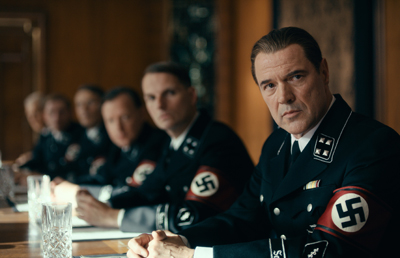 Also, on board again was "Simone Bär, our brilliant casting director who was already famous before The Lives Of Others, she did the casting for Good Bye, Lenin! Since then she has worked with Quentin Tarantino in Inglourious Basterds, Stephen Daldry in The Reader, and Wes Anderson in The Grand Budapest Hotel – all films that have become a bit of a legend, which certainly has more than a bit to do with her. Since The Lives Of Others, costume designer Gabriele Binder opened a large contemporary costume collection on Ringbahn Strasse in the Tempelhof district of Berlin, which she named Comme des Costumes in tribute to Rei Kawakubo, founder of the fashion company Comme Des Garçons. Angelina Jolie, who understands more about clothing than most, realised that Gabriele Binder is someone even she can take guidance from in this area, and chose Gabriele Binder as the costume designer for her first project as director."
Also, on board again was "Simone Bär, our brilliant casting director who was already famous before The Lives Of Others, she did the casting for Good Bye, Lenin! Since then she has worked with Quentin Tarantino in Inglourious Basterds, Stephen Daldry in The Reader, and Wes Anderson in The Grand Budapest Hotel – all films that have become a bit of a legend, which certainly has more than a bit to do with her. Since The Lives Of Others, costume designer Gabriele Binder opened a large contemporary costume collection on Ringbahn Strasse in the Tempelhof district of Berlin, which she named Comme des Costumes in tribute to Rei Kawakubo, founder of the fashion company Comme Des Garçons. Angelina Jolie, who understands more about clothing than most, realised that Gabriele Binder is someone even she can take guidance from in this area, and chose Gabriele Binder as the costume designer for her first project as director."
Asked about the decisive moments in the long journey of making Never Look Away, Florian Henckel von Donnersmarck concludes: "When Jan Mojto gave the green light, when Max Wiedemann and Quirin Berg came on board, when Simone Bär found me these absolutely fabulous actors, when the broadcasters and sponsors expressed their enthusiasm about the screenplay and decided to support the film in the length and scale that were needed, I knew then that the film was going to be made. And when the amazing department heads came on board, I also knew that I would be able to make it exactly the way I had always imagined it." "This film is for everyone who might be a bit bored with the triviality of so much of what is seen in movie theaters today," confirm Wiedemann & Berg. "Few films today succeed in creating a sense of true grandeur and capturing the audience's imagination. Never Look Away is the best argument, the best reason for going to the movies."
Never Look Away Historical Context by John-Paul Stonard
Throughout the twentieth century in Germany art, history, and individual lives were entwined in a way as complicated as it was dramatic. Art, and in particular painting, became a battleground, the stage for political struggle by other means. During the Weimar Republic the focus of this struggle was the Bauhaus, the school of art and design at which all the leading artists either studied or taught, and which was eventually closed by the Nazi party in the early 1930s, who saw it as internationalist and bolshevist. For the Nazis, modern art was a sign of mental illness, a diagnosis that many in the general public would have agreed with, in Germany and elsewhere. Entartete Kunst, or the 'Degenerate Art' exhibition opened in Munich in 1937 and travelled to a number of German cities. Hundreds of paintings and sculptures by artists such as Wassily Kandinsky, Ludwig Kirchner, Max Beckmann, and Paul Klee, who the Nazi party deemed 'degenerate', were showing alongside derogatory slogans " the works had been confiscated from museums and private collections and were eventually either auctioned off or destroyed. Entartete Kunst was one of the most popular exhibitions of all time, with over two million visitors at the Munich showing alone. Although many went to laugh and jeer, others went to see the paintings in a genuine spirit of curiosity " it was the first large exhibition of modern art ever mounted. The Nazi attack on the cultural world wiped out an entire generation of artists. They were either killed or forced to emigrate or live in the darkness of 'inner emigration', unable to work or to exhibit publicly throughout the twelve years of the Third Reich. For those artists born in the 1930s, and who remained as children in Germany throughout the Nazi period, the experience of the horrors of war, not least the aerial bombardment of German towns, culminating in the total destruction of Hamburg, Dresden, and many other towns and cities, were formative experiences.
Yet after 1945, as knowledge of the horrors of the Third Reich slowly emerged, it was far from clear how artists might reflect back on the history of disaster and defeat. Few artists actually drew the cities of rubble or referred to the collapse of Nazis " all the good artists of the older generation were gone.
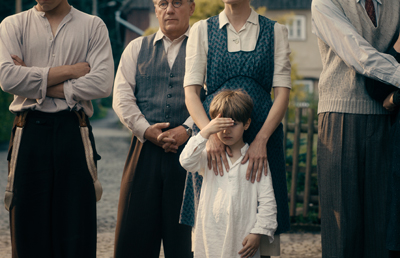 The Allied victors divided Germany into four zones of military occupation, Russia in the east, the French, American and German in the west. Exhibitions of modern art came to play an important role for the military governments to justify their presence and establish links with the defeated German population. Art schools were re-established, and German artists slowly began showing their work. Yet divisions remained, particularly with the violent split of the country in 1949 into two separate states: the GDR, or German Democratic Republic in the east, and the Federal Republic of Germany in the west. In art schools in the GDR the Soviets enforced a strict policy of Socialist Realism, a figurative style of painting showing healthy, productive and positive-minded workers. It was really Nazi art without the muscle-bound heroism. In West Germany art schools embraced the experimentalism and individualism that were the legacy of the early twentieth century avant-garde art movements. The division between these two positions " Socialist Realism versus 'Formalism' (a word that means something like abstraction) " dominated debates at the time, and often hinged on what one thought of the work of Picasso " who could please both camps, but also often neither. In East German art school's traditional techniques of painting were taught, including drawing from the human figure and the glazing technique of painting in oils.
The Allied victors divided Germany into four zones of military occupation, Russia in the east, the French, American and German in the west. Exhibitions of modern art came to play an important role for the military governments to justify their presence and establish links with the defeated German population. Art schools were re-established, and German artists slowly began showing their work. Yet divisions remained, particularly with the violent split of the country in 1949 into two separate states: the GDR, or German Democratic Republic in the east, and the Federal Republic of Germany in the west. In art schools in the GDR the Soviets enforced a strict policy of Socialist Realism, a figurative style of painting showing healthy, productive and positive-minded workers. It was really Nazi art without the muscle-bound heroism. In West Germany art schools embraced the experimentalism and individualism that were the legacy of the early twentieth century avant-garde art movements. The division between these two positions " Socialist Realism versus 'Formalism' (a word that means something like abstraction) " dominated debates at the time, and often hinged on what one thought of the work of Picasso " who could please both camps, but also often neither. In East German art school's traditional techniques of painting were taught, including drawing from the human figure and the glazing technique of painting in oils.
Artists were seen as part of a wider Socialist society in which everyone was to play a role " painters did so by creating inspiring murals for public buildings. There were many good painters in the East, artists such as Willi Sitte, the head of the official union of artists, whose paintings combined figurative imagery with an expressive, unnaturalistic style. But Sitte was first and foremost a Socialist painter.
It was as a Socialist painter that Gerhard Richter had his first success. Born in 1932 and raised near Dresden, Richter had witnessed the horrors of war first hand, and began his career as an artist in East Germany in the years of wiederaufbau " the physical reconstruction of towns and cities. Shortly after finishing his studies at the Dresden Art Academy he was commissioned to paint a mural at the German Hygiene Museum in Dresden, executing what he later described as a 'peace-joy-happiness' scene of figures enjoying leisure time in idyllic surroundings. Yet for Richter, as for many other ambitious East German artists, the lure of the West was too great " to be an artist in cities such as Hamburg, Munich and Cologne was to have money and, above all, creative freedom.
In the years before the Berlin Wall it was relatively easy to cross the border, simply by boarding a local train in East Berlin and alighting in West Berlin. The trick was not to take luggage, which would signal your intention not to return. Richter moved to West Germany with his wife, Ema, in 1961, and settled in the small city of Düsseldorf where he enrolled in the Kunstakademie, the most exciting and experimental art school in Germany at the time. Artists in the West enjoyed freedom, and a sense of being part of an international art scene. Yet they also faced the problem of how to confront the recent past, the actions of their parents' generation, and also themselves " what it meant to be German in the wake of the Third Reich.
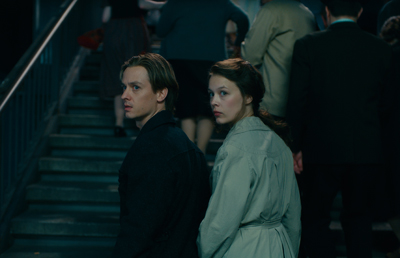 At first it was hardly a subject for art at all " discussion of the Nazi years and the war was taboo. In the decade after Richter arrived in the West the astonishing pace of recovery, known as the Wirtschaftswunder, or Economic Miracle, created a boom time for art in which it was much easier to avoid historical reflection. Yet the traces of it were everywhere " many Nazi officials had simply been re-employed after the War, particularly in the Civil Service. Family photo albums were full of snapshots of relatives in Wehrmacht (German Army) uniforms, and the very fabric of German cities was a permanent reminder of the horrors of war. Many well-known artists studied and taught at the Kunstakademie, but by far the most influential was Joseph Beuys. His charisma, if not his art, had a direct influence on Richter's generation " Beuys held that art was the solution to many social problems, and that making and interacting with art should stand at the heart of democratic society. He was also a mystic, who claimed to have been rescued from a Luftwaffe plane during the war, when he served as a fighter pilot, and kept alive by being swaddled in felt and rubbed fat. He saw felt and fat as magical, charged substance, and used them throughout his career as an artist. Beuys drew on his experiences fighting in the War, but it was for others to vent their anger and disbelief at recent history. As knowledge emerged of the concentration camps, of the mass sterilization of hundreds of thousands of people, and the extermination of millions, the majority Jewish, it seemed both an impossible and morally unavoidable subject for art. Gerhard Richter's approach was brilliant for the straightforward, unwavering view it gave on this history. His combination of family and newspaper photographs, painted in a style that seemed as mechanical as photography (based in part on his training in traditional painting techniques in Dresden) threw light on difficult topics, but avoided commenting on them, or getting entangled in the ideological debates at the time. At a time when debates about art were still dominated by the opposition between east versus west, Socialist Realism versus Abstraction, Richter created paintings that were emptied of all ideology " they didn't tell the viewer what to think, and were also very beautiful to look at, the result of Richter's choice of subject and beguiling technique.
At first it was hardly a subject for art at all " discussion of the Nazi years and the war was taboo. In the decade after Richter arrived in the West the astonishing pace of recovery, known as the Wirtschaftswunder, or Economic Miracle, created a boom time for art in which it was much easier to avoid historical reflection. Yet the traces of it were everywhere " many Nazi officials had simply been re-employed after the War, particularly in the Civil Service. Family photo albums were full of snapshots of relatives in Wehrmacht (German Army) uniforms, and the very fabric of German cities was a permanent reminder of the horrors of war. Many well-known artists studied and taught at the Kunstakademie, but by far the most influential was Joseph Beuys. His charisma, if not his art, had a direct influence on Richter's generation " Beuys held that art was the solution to many social problems, and that making and interacting with art should stand at the heart of democratic society. He was also a mystic, who claimed to have been rescued from a Luftwaffe plane during the war, when he served as a fighter pilot, and kept alive by being swaddled in felt and rubbed fat. He saw felt and fat as magical, charged substance, and used them throughout his career as an artist. Beuys drew on his experiences fighting in the War, but it was for others to vent their anger and disbelief at recent history. As knowledge emerged of the concentration camps, of the mass sterilization of hundreds of thousands of people, and the extermination of millions, the majority Jewish, it seemed both an impossible and morally unavoidable subject for art. Gerhard Richter's approach was brilliant for the straightforward, unwavering view it gave on this history. His combination of family and newspaper photographs, painted in a style that seemed as mechanical as photography (based in part on his training in traditional painting techniques in Dresden) threw light on difficult topics, but avoided commenting on them, or getting entangled in the ideological debates at the time. At a time when debates about art were still dominated by the opposition between east versus west, Socialist Realism versus Abstraction, Richter created paintings that were emptied of all ideology " they didn't tell the viewer what to think, and were also very beautiful to look at, the result of Richter's choice of subject and beguiling technique.
Richter went on to make many works that combined art and history, personal life and national fate, not least his cycle of paintings, October 18, 1977, based on images of the Baader-Meinhof terrorist group. His paintings stand alongside those of artists such as Anselm Kiefer and Georg Baselitz, reflecting back over the violence and tumult of the twentieth century, showing how art can both reveal historical truths and act as a form of reconciliation and understanding in the wake of trauma.
Never Look Away
Release Date: June 20th, 2019
MORE



